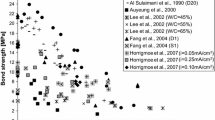Abstract
In many corroding RC structures, it is not uncommon that cover spalling and delamination have occurred. Previous research has been mainly concerned with lower corrosion levels leading to cover cracking. Moreover, the main focus of the available knowledge concerns the corrosion of the main reinforcement; while the corrosion of the stirrups is often overlooked. In an experimental investigation, corrosion attack causing crack initiation, propagation and cover delamination are measured. The specimens have the shape of a beam-end and are corroded with an accelerated method. The location of the bar, middle and corner placement; the amount of transverse reinforcement; the corrosion level of longitudinal reinforcement and of transverse reinforcement are studied. The specimens after corrosion are also used in pull-out bond tests; the results are presented in a companion paper subtitled “Part 2. Anchorage Capacity”. The first test results of the ongoing experimental campaign are presented. The crack patterns are analysed, showing differences between specimens with or without stirrups and when stirrups are corroding or not. Finally, the effect of corrosion was simulated as the expansion of corrosion products in a finite element model and the results, mainly the crack pattern, were compared with the test results. The conclusions address the importance of taking into consideration both high corrosion levels and the corrosion of the stirrups for the assessment of deteriorated structures.
Access this chapter
Tax calculation will be finalised at checkout
Purchases are for personal use only
Preview
Unable to display preview. Download preview PDF.
Similar content being viewed by others
References
Diana, DIANA Finite Element Analysis, User’s Manual, release 9.1, TNO Building and Construction Research, Delft, Netherlands, 2006.
D. A. Hordijk, Local Approach to Fatigue of Concrete, Doctoral thesis, Delft University of Technology, Delft, Netherlands, 1991.
E. Thorenfeldt, A. Tomaszewicz, J. J. Jensen, Mechanical properties of highstrength concrete and applications in design, Conference on Utilization of High-Strength Concrete, Stavanger, Norway, 1987.
K. Lundgren, Bond between ribbed bars and concrete. Part 1: Modified model, Magazine of Concrete Research, 57 (7) (2005) 371-382.
K. Lundgren, Bond between ribbed bars and concrete. Part 2: The effect of corrosion, Magazine of Concrete Research, 57 (7) (2005) 383-395.
Y. Liu, R. E. Weyers, Modeling the time-to-corrosion cracking in chloride contaminated reinforced concrete structures, ACI Materials Journal, 95 (6) (1998) 675-681.
F. J. Molina, C. Alonso, C. Andrade, Cover Cracking as a Function of Rebar Corrosion. 2. Numerical-Model, Materials and Structures, 26 (163) (1993) 532-548.
D. Coronelli, P. Gambarova, Structural assessment of corroded reinforced concrete beams: Modeling guidelines, Journal of Structural Engineering, 130 (8) (2004) 1214.
K. Lundgren, Modelling the splitting effects of corrosion in reinforced concrete, Computational Modelling of Concrete Structures, Euro-C Conference, St. Johann, Austria, 2003, Balkema, 491-500.
K. Zandi Hanjari, Load-Carrying Capacity of Damaged Concrete Structures, Lic. Thesis, Department of Civil and Environmental Engineering, Chalmers University of Technology, Gothenburg, 2008.
K. Lundgren, A. S. S. Roman, H. Schlune, K. Z. Hanjari, P. Kettil, Effects on bond of reinforcement corrosion, International RILEM Workshop on Integral Service Life Modeling of Concrete Structures, 5-6 November 2007, Guimaraes, Portugal, 2007, RILEM Publications S.A.R.L, 231-238.
K. Bhargava, A. K. Ghosh, Y. Mori, S. Ramanujam, Model for cover cracking due to rebar corrosion in RC structures, Engineering Structures, 28 (8) (2006) 1093-1109.
Author information
Authors and Affiliations
Editor information
Editors and Affiliations
Rights and permissions
Copyright information
© 2011 RILEM
About this paper
Cite this paper
Coronelli, D., Hanjari, K.Z., Lundgren, K., Rossi, E. (2011). Severely Corroded Reinforced Concrete with Cover Cracking: Part 1. Crack Initiation and Propagation. In: Andrade, C., Mancini, G. (eds) Modelling of Corroding Concrete Structures. RILEM Bookseries, vol 5. Springer, Dordrecht. https://doi.org/10.1007/978-94-007-0677-4_13
Download citation
DOI: https://doi.org/10.1007/978-94-007-0677-4_13
Published:
Publisher Name: Springer, Dordrecht
Print ISBN: 978-94-007-0676-7
Online ISBN: 978-94-007-0677-4
eBook Packages: EngineeringEngineering (R0)




